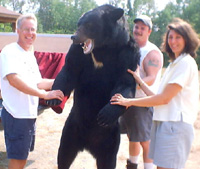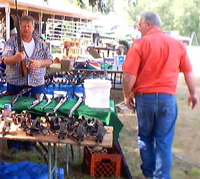|
It has been a bad couple
of months for anti-gun forces in NY with losses in both the NAACP
trial and AG Spitzer's case. In
May, the12-member advisory jury in the NAACP case found
unanimously for 38 of the industry defendants and found for
seven other
defendants by a vote of at least 10 of the 12 jurors, and
in 23 additional instances the jury failed to come to a decision.
Not a single defendant was found to be either intentionally
or negligently responsible for a public nuisance the NAACP
claimed.
Because the NAACP was able to "shop around" for a Judge,
they were able to get Judge Jack B. Weinstein, one of the
most liberal
and activist judge
that anyone can find and the way the trial was set up, the Jury
was
only an "advisory" jury so the Judge could still rule any way
that he wanted to. Weinstein presided over the 1999 NY court case Hamilton
v. Accu-Tek, the only case in which a jury has awarded damages based on
the
negligent
marketing theory.
Even after the Jury found against the NAACP, it was still
expected
that the Judge would find some way to rule in the NAACP's favor.
Judge Weinstein's ruling will come as a shock to
many because he found that the NAACP proved its members "did suffer
relatively more harm from the nuisance created by the defendants through illegal
availability of guns in New York," … "It failed,
however, to show that its harm was different in kind from that suffered by other
persons in New
York," so the NAACP lost its case. The Judge did say that the NAACP
was right and that gun makers did have "careless practices." and failed "to
eliminate
or even appreciably
reduce
the
public
nuisance
they individually and collectively have created. That is totally the reverse
of what the Jury found. " The
judge
also
wrote
that
courts
should create "new legal solutions ... to overriding social problems even
when other branches of the government are heavily involved in attempting to solve
the problems." (Just what the NY Court in the Spitzer case stated that Courts
and
Judges
should
not do.)
Judge Weinstein's opinion in the NAACP case is
the same one that
has
already
failed
in
both
the
Hamilton v. Accu-Tek case,
(
where, in a 7 to 0 decision, that the plaintiff's theories of liability
were
all
without
merit) and
in AG
Spitzer's
case in NY v Ruger. It is hard to see how an appeal will do any better but
Weinstein is not sitting on the Federal U.S. District court and the other cases
were in NY State court. The lawyer in both the Hamilton and NAACP case was Elisa
Barnes.
|
|
In People of the State of NY v Sturm,
Ruger & Company, Inc., dt al., AG Spitzer sued 9 gun manufacturers
and 12 wholesalers, including Sturm,
Ruger & Company
Inc. and Beretta U.S.A. Corp under a section
of PL 400.05 that states: "Any weapon, instrument, appliance
or substance specified in article
two hundred sixty-five, when unlawfully possessed, manufactured,
transported or disposed of, or when utilized in the commission of an
offense, is hereby declared a nuisance." Spitzer also
sued claiming "that illegally possessed handguns are a common-law
public nuisance because they endanger the health and safety of a significant
portion of the population; …" and
that everyone connected with the making, distributing and selling of
guns "maintained a public nuisance by their respective manufacturing,
distributing
and
marketing practices." by knowingly placing "a disproportionate
number of handguns in the possession of people who use them unlawfully."
Spitzer has lost at every turn. When Judge York
ruled against him, Spitzer appealed the part of the case that had to deal with
the common-law public nuisance and gave up on the PL 400.05 part of the lawsuit.
The case was the first case that Spitzer has personally argued since taking office
in 1998.
The Appeals Court ruled 3 to 1 that "our reading
of
Hamilton suggests the Court's resolve to maintain its present and long standing
posture of denying liability where the causal connection between the alleged
business conduct and harm is too tenuous and remote." … "generally,
defendant gun manufactures do not owe a "duty to control the conduct of
third
persons so as to prevent them from harming others, even where as a practical
matter defendant can exercise such control."". Further the ruling stated:
"… giving
a green light to a common-law public nuisance cause of action
today will, in our judgment, likely open the courthouse
doors to a flood of limitless, similar
theories of public nuisance, not only against these defendants,
but also against a wide and varied array of other commercial
and manufacturing enterprises
and
activities.
All a creative mind would need to do is construct
a scenario describing a known or perceived harm of a sort
that can somehow be said to relate back to the way a company or an industry makes,
markets and/or
sells its non-defective, lawful product or service, and a
public nuisance claim
would be conceived and a lawsuit born. …"
AG Spitzer can appeal
the decision to the Court of Appeals, NY State's highest court, however
that is who wrote the Hamilton v. Beretta decision that was quoted
and relied on in this decision. No one would expect for the Court
of Appeals to rule 180 degrees from that decision and
that is
what would be required for them to allow the People v. Ruger lawsuit
to continue.
One can expect AG Spitzer to appeal
the decision just so he can use it a a political point when he runs for governor.
He can call for NY state law to be changed so that these types of
lawsuits
can be brought or a law that requires that anyone making, distributing
or selling guns in NY State be required to follow the outline on
conduct that AG Spitzer was pushing when he negotiated with the gun
industry in 2001. Then he wanted to require that gun makers track
gun
dealers
who
sell
guns that end
up being used
in
crimes
and
require
that gun makers and
dealers
take measures such as limiting the number of guns a customer can buy
in any given time and make other changes. These are the talks
that
S&W agreeded to comply with and the failure of the other gun makers to go along
with the deal is why AG Spitzer brought this lawsuit.
Jan. 31, 2001 Case is argued before Acting Justice Louis B.
York
Aug. 24,
2001, Judge Louis York dismisses Spitzer's lawsuit.
May 2002, Spitzer argued case in the Supreme Court, Appellate
Division, 1st Department
June 24, 2003, Spitzer looses appeal to Supreme Court, Appellate
Division, 1st Department
Other Articles:
Hamilton v. Beretta NY Court of Appeals decision.
|


 The conservative pro-gun Orange
Co. Democrat was first elected in 1992 and recently announced
his intent to run for re-election in spite of his illness. Gunther
sponsored several important gun bills and served on the Environmental
Conservation Committee. He was appointed to the Legislative
Commission on Rural Resources by Sheldon Silver in 2001.
The conservative pro-gun Orange
Co. Democrat was first elected in 1992 and recently announced
his intent to run for re-election in spite of his illness. Gunther
sponsored several important gun bills and served on the Environmental
Conservation Committee. He was appointed to the Legislative
Commission on Rural Resources by Sheldon Silver in 2001. Everyone
had a great time at last years event and they get bigger every
year.
Everyone
had a great time at last years event and they get bigger every
year. They
have several events planed and everyone should have a great time.
On August
16th they will have a Handgun silhouette shoot 10am, handguns only
large caliber preferred, 25-100 yards for info call Dante @845-344-0804.
and on August 17th, the TRICOUNTY ARCHERS will have a 3D SHOOT,
7am-1pm, for info call Carl @845-733-5473 or Jeff @845-343-6417.
They
have several events planed and everyone should have a great time.
On August
16th they will have a Handgun silhouette shoot 10am, handguns only
large caliber preferred, 25-100 yards for info call Dante @845-344-0804.
and on August 17th, the TRICOUNTY ARCHERS will have a 3D SHOOT,
7am-1pm, for info call Carl @845-733-5473 or Jeff @845-343-6417.